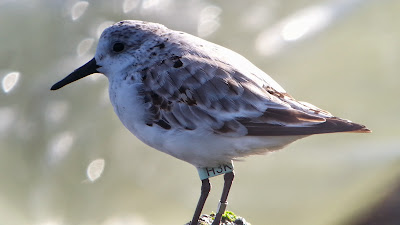While we were away in Cape May we were fortunate to catch up with a few colour ringed birds. I have now had all the information back and it makes interesting reading.
In all, we found 7 sanderling, 2 western sandpiper, 1 American oystercatcher and a great black backed gull.
Great black backed gull OX4 - ringed on Appledore Island in Maine on July 18th 2012. My sighting at Cape May was the 1st since it was ringed
American oystercatcher M3 - ringed as a chick in Northhampton, Virgina on July 15th 2008 and my sighting was the first since it was ringed.
Western sandpiper - lime green PT3 and HU3 were both ringed together at Stone Harbor in New Jersey on October 3rd 2007. Both birds have been seen in New Jersey several times since
Sanderling - all lime green flags and ringed as part of the same scheme.
Y6X, T0K and O1Y- all ringed on May 19th 2014 at Villas Beach, New Jersey. T0K has also been seen in Delaware.
H3K - ringed at Stone Harbor on May 31st 2011.
2AT - ringed on Villas Beach, New Jersey on June 1st 2010.
X0Y - you will have to stick with me on this one. This bird was originally ringed on May 14th 2007 with the flag code YL0 on Reeds Beach in New Jersey and was sighted in Mexico in 2011. The bird was recaptured in New Jersey in May 2011 and was found without its original colour flag so was retagged with X0Y. Hope you followed all that!!
Pic 1 - great black backed gull OX4
Pic 2 - sanderling X0Y (YL0) in Mexico in 2011
Pic 3 - sanderling H3K at Stone Harbor this October




























































